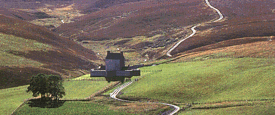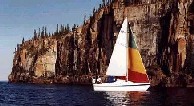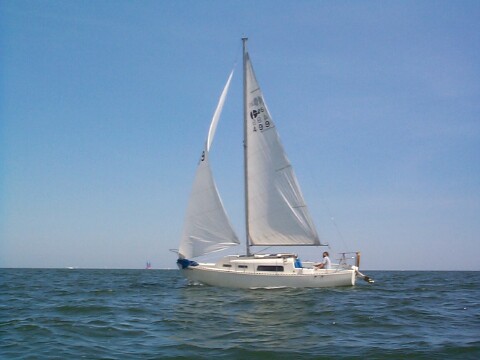HISTORY
OF GRAMPIAN MARINE
(Research
by Peter
Davidson
and compiled primarily from information provided by Jim
Bisiker,
Founder and Owner of Grampian Marine Limited; Gill
Bibby
- Finishing Production Manager and Ewan
Campbell,
Sales Manager. )
RETURN to GRAMPIAN HISTORY
The Start-up
It
was in the late 1950’s that Jim Bisiker’s construction company encountered
troubled times. New
jobs were scarce and those upon which he bid were awarded to his competitors
who soon found that, by underbidding, they were on the path to bankruptcy.
times. New
jobs were scarce and those upon which he bid were awarded to his competitors
who soon found that, by underbidding, they were on the path to bankruptcy.
At
this time, the use of fibreglass for the boat building industry was in its
infancy. Dyer
Yachts in Rhode Island were pioneering the techniques and building offshore
powerboats in this new material.
It was here that Jim, in company with Dirk Kneulman and John Burn, went
to learn how to work with fibreglass.
They paid Dyer Yachts for this privilege and came home with the
required knowledge to begin boat building in Ontario.
Grampian Marine is Born
Grampian
Marine Limited was born in the early sixties. The name came from the Grampian
Mountains in Scotland where Jim Bisiker’s grandmother lived in Aberdeen.
Jim’s construction company owned property on Woody Road in Oakville
where a fibreglass plant was built in the back and the construction of Dyer
designed boats begun under license. At
first they made ten-foot sailing dinghies and small powerboats - the plant
grew like topsy.
There was a brief period when they imported and sold Sheerwater
catamarans that were built by Fairey Marine in Hamble, England.
Fairey was known for their building of Motor Torpedo Boats during WW
11.
The
Triangle, US Yachts and O'Day Connection
Then along came a group from the US wanting Grampian to build boats for
them. They included Chuck Angel
from Rochester, NY, who had designed the Triangle 20 and Triangle 32, a
spacious centre cockpit cruising yacht, and later the US 42 which later became
the 46. Marketing was done
by US Yachts, whose principals included Bob Larsen (from the Time Life
Magazine family) and Warren Dellenbaugh.
Both Bob and Warren were from Connecticut, and were in turn also
associated with the formation (in Fall River, Mass.) of O’Day Yachts, with
George O’Day and the O’Day company president, Lyman Bullard.
Thus Grampian commenced building not only the US Yachts line, but also
(for the Canadian market only) the O’Day line of day-sailers. Also at this time O’Day was introducing the new Ray Hunt
designed offshore powerboats and Grampian helped with some of the initial
production and tooling, but chose not to continue into the full production
phase. Jim says that these
business relationships developed into very friendly and compatible meetings of
the minds.
The sixties were heady times in the boat building business.
Mass production of fibreglass boats made sailing a sport that many
could enjoy. Unlike to day, there
were no used fibreglass boats for sale - everyone bought new.
During the late-sixties, O’Day approached Grampian Marine with an offer to buy them but Jim Bisiker turned them down. However O’Day did purchase US Yachts and Triangle Marine and four months later, much to Jim’s chagrin, went public on the New York Stock Exchange. Grampian Marine continued to build boats for O’Day but they were not part of the NYSE Package.
Grampian
builds other models
Grampian
then acquired a license to build 15 foot Albacores for Fairy Marine.
Fairey was annoyed that Whitby Boats were also building them.
It was alleged that Whitby had taken the design and changed the
registered name from Albacore to Albatross.
Also built under license by Grampian were Snipes and 420’s (a 14 foot
racing class dinghy for which the Canadian Government placed an order for
fifty) the Classic 22 and the G 17 cuddy-cabin dinghy and the Flying Ten, a
Dutch design by Van der Stadt.
The earliest record of a Grampian Marine built boat uncovered by this
research comes from Keith Hobbs of Ottawa.
He has provided information on the boat that he currently owns – a
1963 Triangle 22, number 107. He has sent a copy of the sales brochure from US
Yachts, original registration and the manufacturers plate – Grampian Marine.
Grampian starts its own designs and Alex McGruer comes aboard
Grampian
Marine Limited then began it’s own designs in response to substantial orders from other dealers in the US especially George Walton Yachts of Annapolis, Md..
These included the Classic 31 designed by a naval architect in
Annapolis, Peter van Dyne, and the Sparkman and Stephens designed Classic 37.
About thirty to forty of these boats were built before the sixties
designs were dropped in favour of the newer fin keelboats.
from other dealers in the US especially George Walton Yachts of Annapolis, Md..
These included the Classic 31 designed by a naval architect in
Annapolis, Peter van Dyne, and the Sparkman and Stephens designed Classic 37.
About thirty to forty of these boats were built before the sixties
designs were dropped in favour of the newer fin keelboats.
Subsequently Grampian took on its own in-house designer Alex McGruer.
Alex grew up within the bounds of McGruer & Co Ltd. - a family boat
building business in Clydner on The Clyde established in 1911.
He began his boat building apprenticeship there in 1943, training as
draftsman, loftsman and finally yacht designer. Besides the admirals barge on the royal yacht Britannia, he
was also involved in the design of the 8 metre racing yacht ‘Innismara’
which won the Lloyds Yacht of the Year award in the sixties.
Alex McGruer II, M.S.N.A.M.E., was given the parameters to design boats
with good sailing abilities and yet providing comfort.
He began with the popular Grampian 26 followed by the G 30 and later
the trailerable G 23.
Jim Bisiker has no records or a date of when the various boats were built or exact numbers made but does recall that the G 23 was not as successful as had been hoped – only about two to three hundred were built. The G 26 was more successful - about a thousand were made. The G 30 was also popular and about four hundred were built before the plant closed in the late ‘70’s. Also built was the G 34 - a modification of the Triangle 32.
Ewan
Campbell joins
In 1972 Ewan Campbell, joined Grampian and was in charge of retail and
dealer sales, customer relations, shipping, commissioning and service.
He recalls the following more specific details:
Grampian Model Chronology
G
26 designed in 1969 about 980 built plus # 999 a special production order.
G
23 designed in 1972 - about 300 built.
G
28 designed in 1975 - 107 built – designed in house by Rolf van der Sleen
with a view to competing in the half-ton racing class.
G
30 designed in 1969 about 350 built
G
30 Cutter rig designed in 1975 about 50
built
G
34 designed in 1973 about 50 built – based on the Triangle 32 and the design
reworked in house by Axel Schmidt.
G
2-34 designed in 1974 about 50 built
G
46 designed in mid 60’s about 300 built – this began life as a 41 footer.
Discovery
7.9 completed in time for the 1975 Toronto Boat Show.
The Discovery 7.9 was based on the G 26 retaining the sweet hull lines
but with a new, higher deck and coach roof – very few were built.
Ewan
remained with Grampian until the end in the summer of 1977.
Working for the receivers, he stayed on to complete some boats already
under construction. At that time
the G 28s were just taking off and tooling up was being started for the new
McCurdy & Rhodes design Heritage 35 that had been built by a company in
Rexdale, Ontario. About twenty
had been built before Grampian bought the moulds and took on a couple of their
key men before Grampian’s doors were closed.
Grampian’s doors were closed.
The last G 30 was built from start to finish by the receivers - the
owner allegedly receiving a real custom job.
He wanted extra glass in the hull and decks and provided his own
hardware such as bronze opening ports – Ewan describes it as a real beauty.
Does anyone know anything about this boat that may be numbered 350?
Ewan
feels that the future was looking good but refers to himself as ‘the last
man out the door’! He recalls that Cape Dory bought the 28 and the 35 – the
two newest designs.
Much of the Grampian production was destined for the US and a plant had
been opened in North Carolina. The
Woody Road, Oakville and the North Carolina plants both built the 26, 30 and
the 34-foot designs. Only a
couple of 46-foot boats were built in Oakville - the rest were built in N.
Carolina.
Gill Bibby (Read Gill Bibby's Story)
In
Grampian Marine’s heyday, Gill Bibby was in charge of running the Oakville
plant. He began with Grampian in
1968 as a ships carpenter and boat builder. He later became foreman and the
finishing production manager. When
he began, the G 30 plug was being built and two G 26 boats were being
assembled. A year later a new
production management team made changes.
Gill was made a lead hand and the new G 26 production line was started.
Within six months four G 26s were being produced each week.
Later the same thing happened with the G 30 - one being produced every
two weeks.
Gill remained with Grampian until the end in July 1977. He had been sent to N. Carolina in March of that year to
finish up a 46 boat only to return that summer to find the Oakville plant in
receivership!
The
main competition to Grampian was Pearson in the US and Whitby Boats in Canada.
There was a time when George Cuthbertson of C & C approached
Grampian to suggest a merger. C & C boats were of a racing design whereas Grampian was
pursuing the cruising market. It
seemed like a good partnership but nothing came of it.
Jim Bisiker, living in Port Credit, Ontario, always had other interests
besides boat building. He admits
that, while he was the major shareholder, he did not spend a lot of time in
the Grampian plant – ‘I did not spend a lot of time at the company –
just a lot of dollars!’ In the
mid-sixties, his other activities began to occupy more and more of his time.
Jim talks about the great team that he had around him to run the
operation while he spent little time there.
Financial Problems for Grampian
When
Grampian Marine Limited began the Canadian dollar was worth about .70c US but
in 1977 it was at an all time high of about $1.04 US. American built boats were being brought into Canada and sold
at a price less than that for which Grampian could build them.
The N. Carolina plant could not handle the demand and sales were
diminishing. It was at this time,
Jim admitted, that that Grampian Marine was suffering financially and that his
other businesses were more important. He
had little to do with the day-to-day operating of the company.
The value of the dollar and the competition were becoming a problem and
Jim was concerned with the volume of sales.
On
top of all this a number of the members of the company, including the senior
bookkeeper, expressed concerns with regard to the handling of the company’s
financial affairs. Jim called in
the auditors but they could not detect anything untoward.
The company finally went into receivership, the assets were sold before
bankruptcy was declared and Grampian Marine Inc. was wound up.
Boatyard closures
And
so the two plants were shut down. Price
Waterhouse, acting as receiver, sold the Oakville assets to different buyers.
The real estate, owned by Jim, was also sold separately.
The North Carolina plant was taken over by Tanzer.
What
happened to all the other old designs?
When Grampian went out
of business a fellow in St Mary's, Ontario, bought the 34-foot molds and made
ten boats that he called ‘Seaforth 34's’.
There may be one here this weekend.
Looking back, Jim now aged 72 and spending his time between his
properties in Toronto and Beaulieu, England, realizes that originally he never
had any great ambitions to build boats. He
always liked boats and the sea and he just happened to be in the right place
at the right time. He had the
people and the premises and the right contacts.
He was in on the ground floor in the fibreglass boat building industry
and also pioneered the idea of modular construction which kept the prices down
and that was the key to the Grampian success.
Grampian owners and stories
Grampian
Marine had some high profile customers who owned Grampian boats.
One was a Toronto surgeon who would leave the operating theatre to take
a telephone call from his salesman when calling about his new order!
Murray Koffler of Shoppers Drug Mart; Ben Dunkelman of Tip Top Tailors;
the president of Radio Shack were all customers of Grampian Marine. In the US, the inventor of the Aero Spray bomb was also a
Grampian owner.
Also notorious, but of lesser fame, were the hobos who would hop aboard
the boats being shipped to Vancouver by rail.
Tales of masts that were in their way being cut free and dumped in the
Prairies and interiors destroyed where fires had been lit, haunted the dealers
upon arrival on the West Coast. The
culprits had enjoyed first class accommodation and comfort during their free
rides across the country!
Jim recalls, with some satisfaction sometime later, seeing a Grampian 30
sailing out of New York into the Atlantic Ocean.
After crossing the Atlantic onboard the QE 2, he saw another G 30
sailing into the waters off Southampton, England. While the owner is not known, there is a story in the early
seventies, of a Grampian 26 being sailed down the St Lawrence, into the
Atlantic, down the East coast, through the Panama Canal and up to Seattle on
the West coast. Another G 26 was
sailed to Europe from New York by Dick and Theda Morris. They cruised there for two years before returning to Key West
via the West Indies in the same boat.
On the not so pleasant side, but nonetheless a story with a happy
ending, a G 30 is said to have run aground off Cape Hatteras during a severe
storm. So severe in fact that the
crew, that had remained on board while the boat was being pounded, lay flat
for four hours as the only way to save themselves. The tide ebbed leaving the
boat high a dry and when it flowed again, the boat floated off.
After limping back to port, it was found that the only damage sustained
was some straining of the keel bolts! Tough
boats, these Grampians!